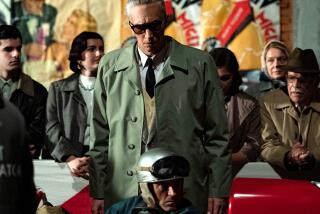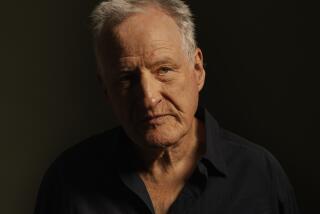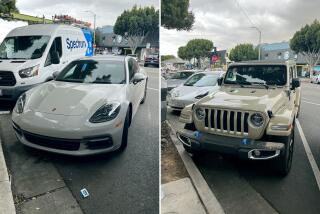Redesigned and redefined
- Share via
Ezra POUND was many things: poet, aesthete, anti-Semite, battier than Carlsbad Caverns. Among the founding fathers of Modernism in the 20th century, Pound was also the one most full of self-regarding fertilizer. If overwriting is a crime, Pound is literature’s Al Capone.
But Pound had it right when he observed that works of art often center on a single defining metaphor, a still point of meaning around which the larger work spins like a gyre -- thus Pound’s critical term “vorticism.”
Man, it’s great that degree in literature is finally paying off.
It’s fair to say I hadn’t thought of Pound since the moment I put down my pencil in graduate school -- until I climbed into the cockpit of the redesigned Porsche 911 Carrera S. There, atop the richly upholstered dash, was a handsome stopwatch-style chronometer. Want to test yourself on a favorite piece of road? Tap a wand on the steering column and the instrument’s sweep-second hand and digital readout begin to march forward with unappeasable accuracy. Now you can time exactly how long it takes to lose your license.
The chronometer is a little bit of genius, design as metaphor. If you had to choose an image to capture the soul of the Porsche 911 -- a car with thousands of road-racing victories to its credit, a car that virtually owns the production-based classes at Le Mans, Daytona and Sebring -- that image wouldn’t be a wheel, or an engine or even the raring black stallion on the Porsche escutcheon. It would be a stopwatch.
After all, speed is distance over time. Though it might seem, for instance, that Le Mans-style endurance racing is about wheel-to-wheel combat, this is an illusion. Over 24 hours, it is purely the arithmetic accretion of lap times and pit stops that brings one driver to the finish line before another. The cars’ daring proximity is pure coincidence.
The chronometer underscores the authenticity of both car and driver. It sits there, front and center, demanding answers. As any racer who has ever turned the wheel in anger knows, there is no hiding from a stopwatch. It is the ultimate arbiter of who has game and who just has a big mouth.
The latest overhaul of the 911 is known as the 997 generation -- the previous model was the 996, and before that the 993 (spanning the model years 1993-98), the last of the air-cooled Porsches. The new 2+2 sports car retains the sleek overall profile and wet-seal surfacing of the car it replaces but reaches back to the 993 generation for some classic touches, most notably the oval headlamps ahead of the browed front fenders. Gone are the amoeba-shaped compound headlamp assemblies, never much loved by Porscheophiles. Also, the new car is slightly wider and its rear fenders -- enclosing bigger wheels and tires -- have more dramatic swales, like those of the 993’s turbo edition. Even so, thanks to many hours in the wind tunnel, the new car has lower aerodynamic drag values and more road-gripping downforce at speed.
There are two versions of the 911, the Carrera and the Carrera S, the latter getting a stronger engine (a 3.8-liter, 355-horsepower flat six, compared with the Carrera’s 3.6-liter, 325-horsepower unit), bigger wheels and tires (19-inchers versus, compared with 18s), larger cross-drilled brake rotors, bi-Xenon headlamps and variable-damping suspension. The 2005 Turbo Carrera S is a carry-over from 2004 and a turbocharged version of the new car can be expected next year.
The S version of the Carrera is easy to spot by its twin double-barreled exhaust. Either car looks like something you could split rails with.
The dash-mounted timekeeper is part of the new Sport Chrono Plus system. Activating the “Sport” button raises the rev limiter threshold and makes the electronic throttle response more aggressive. The variable damping system goes all flinty. Also affected are the thresholds for stability control and anti-lock brake intervention, allowing the driver to toss the car around a bit more before the computer nannies step in.
With a top speed of more than 180 mph, the Carrera S is a potent car but doesn’t feel overwhelmingly quick -- the six-speeder I drove didn’t have the crossbow acceleration of other sports cars in its class. The 3,131-pound car sprints to 60 mph in 4.6 seconds; the new Corvette, for instance, reaches 60 mph half a second sooner. Despite the Porsche engine’s variable valve timing and lift and two-stage induction system -- all intended to spread torque into the lower revs -- the flat-six really only wakes up above 4,000 rpm. If you are tooting along at 70 mph in sixth gear and you need to wiggle through a gap in traffic, you have to downshift all the way to third to rouse the engine.
Your reward is a sound as if you’ve poked Grendel with a stick. The induction system’s butterfly valve opens, changing the engine note from a guttural purr to a full-throated metallic howl.
This is a hard, stiff car, with an icy competence about it. The leather on the steering wheel, dash and seats feels like the skin of a baseball. The weight of the shifter and clutch is heavy and perfectly balanced; the gear lever throw is noticeably shorter and quicker in the new 911. The lever slides through the shift gates with a well-honed accuracy. (The five-speed Tiptronic automatic transmission is optional.) You don’t sit in the deep-bolstered bucket seats as much as plug into them -- and, incidentally, this car’s seats are not generously cut, so if you’ve put on 30 or 40 pounds of midlife lard, you might want to shop elsewhere.
Out in the canyons, the new 911 feels like the front roller-coaster car at Six Flags Over Asphalt. The lateral grip and transitional stability is excellent. The car’s stance has been widened (the track is up 0.82 of an inch in the front and 1.33 inches in the rear), and the car is shod with broader radials (9 inches wide in the front and more than 11 inches wide in the rear).
With all that grip underfoot, it’s actually quite hard to get the car to slide at all. The best way to rotate the rear end is to go heavy on the brakes, turn in and let off the brakes at the same time. (Remember to switch off the stability control.) Only then will the 911 exhibit any of its former tail-wagging tendencies. The weight balance of the car is still decidedly rear biased, 37.7% front and 62.3% rear. Otherwise, it tracks with slot-car precision over anything public roads can throw at it.
Our test car was also equipped with the Porsche Active Suspension Management system (which is not really “active” so much as variable damping). Like the stability control, the active suspension operates at two thresholds, normal and sport. On rough, uneven roads, when a softer suspension damping helps the car maintain contact with the asphalt, the damper’s internal valves open up to allow freer movement of the damper’s piston. When the surface is smooth, the computer tells the damper to firm up. All of this happens in digital time and without the driver being much aware of it; you simply walk away sputtering about the car’s effortless, heroic road-holding.
It’s a pretty amazing car, with so well rounded a portfolio that it may be hard to judge how much better it is than the last car. Here, the stopwatch comes in handy. According to Porsche, the new Carrera S with the Active Suspension feature is 5 seconds quicker around the 14-mile, 170-plus-turn Nordschleife course at Germany’s Nurburgring.
There are race drivers who would sacrifice their left precious to gain 5 seconds around the Nurburgring.
The brakes are terrific (heat-shedding ceramic brakes are an option.) The revised suspension -- an aluminum-intensive system of McPherson struts and transverse links up front and multi-links in the rear -- keeps the car planted and stable.
Is it perfect?
I can’t say I’m crazy about the car’s variable-ratio steering, a rack-and-pinion system in which reactivity builds up the farther you turn the wheel off center. The steering feels oddly lazy in straight-ahead driving and becomes busy and temperamental in cornering. I prefer a direct, linear relation between turns of the wheel and steering angle. I’m old-fashioned that way, I guess.
Performance driving is something Porsche gets. The company’s interior design, on the other hand, has been suspect, and the most dramatic change to the 911 is on the inside. The instrument panel of five interlocking circular dials rimmed with satin aluminum is larger and easier to read. Gone is the cheap plastic central console, replaced by a multi-function control panel integrating climate, audio, navigation and mobile phone systems around a bright, easy-to-sort liquid crystal display screen interface. The tabbed rotary dials from the Cayenne’s climate control are here. Also, the first-order functions of the system all have their own buttons so you don’t need to hunt for them in some branching heuristic menu. The design quality reminds me of a Panasonic Toughbook laptop.
New for this year are a multi-function steering wheel, tilt and telescopic wheel adjustments, and a variety of switch enhancements to replace the shiny plastic ovals of the past. Porsche has attempted to simplify its often baffling structure of options and packages, but it’s still possible to personalize your Porsche pretty thoroughly, with 17 exterior paints, nine leather and carpet colors, and interior surfaces that include macassar and sycamore wood, carbon fiber and satin aluminum.
The environment is richer, warmer, and -- this is key -- more deserving of a high-priced automobile.
Ever since Steve McQueen stepped out of a Porsche 911 in the 1971 movie “Le Mans” (by the way, did anyone ever look half so cool in a mock turtleneck?), the 911 has been the driving purist’s choice. That reputation took a hard hit when the Porsche began building water-cooled cars and sharing parts with the softer and more suburban Boxster.
Cynics might argue the addition of cup holders is the final travesty in the 911’s domestication.
The 911 is no longer the hard-edged sports car it once was, the John the Baptist of performance driving. Yet it’s hard to walk away from the 911 unsatisfied. Things change. Companies and markets move on. And as the chronograph never fails to remind us, time flies.
*
Automotive critic Dan Neil can be reached at dan.neil@latimes.com.
*
2005 Porsche 911 Carrera S
Base price: $79,100
Price, as tested: $92,355
Powertrain: Rear-mounted, 3.8-liter, dual-overhead cam, 24-valve, horizontally opposed six-cylinder engine, with variable valve timing and lift, integral oil-sump lubrication; six-speed manual transmission; rear-wheel drive.
Horsepower: 355 at 6,600 rpm
Torque: 295 pound-feet at 4,600 rpm
Curb weight: 3,131 pounds
0-60 mph: 4.6 seconds
0-99 mph: 10.7 seconds
Top track speed: 182 mph
Length: 175.6 inches
Wheelbase: 92.52 inches
Cargo volume: 4.76 cubic feet
EPA mileage: 17 miles per gallon city, 25 mpg highway
Final thoughts: Rocks around the clock






